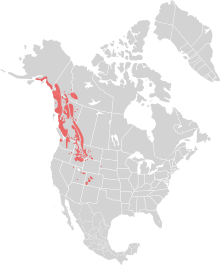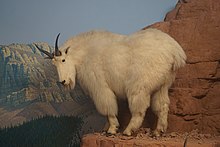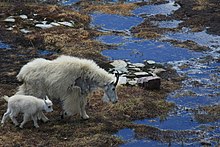Mountain goat
| Mountain Goat | |
|---|---|

| |
| Mountain goat in the Cascades | |
| Scientific classification | |
| Domain: | Eukaryota |
| Kingdom: | Animalia |
| Phylum: | Chordata |
| Class: | Mammalia |
| Order: | Artiodactyla |
| Family: | Bovidae |
| Subfamily: | Caprinae |
| Tribe: | Caprini
|
| Genus: | Oreamnos |
| Species: | O. americanus
|
| Binomial name | |
| Oreamnos americanus (Blainville, 1816)
| |

| |
| Synonyms | |
| |
The mountain goat (Oreamnos americanus), also known as the Rocky Mountain goat, is a
Despite its vernacular name and both genera being in the same subfamily (
Classification and evolution
The mountain goat is an even-toed
Given that all major caprine lineages emerged in the
The mountain goat is the
General appearance and characteristics

Both male and female mountain goats have beards, short tails, and long black horns, 15–28 cm (5.9–11 in) in length, which contain yearly growth rings. They are protected from the elements by their woolly greyish white double coats. The fine, dense wool of their undercoats is covered by an outer layer of longer, hollow hairs. Mountain goats molt in spring by rubbing against rocks and trees, with the adult billies shedding their extra wool first and the pregnant nannies shedding last. Their coats help them to withstand winter temperatures as low as −46 °C (−51 °F) and winds of up to 160 kilometres per hour (99 mph).

A male goat stands about 1 m (3.3 ft) at the shoulder to the waist and can weigh considerably more than the female (around 30% more in some cases). Male goats also have longer horns and longer beards than females. The head-and-body length can range from 120–179 cm (47–70 in), with a small tail adding 10–20 cm (3.9–7.9 in).[4][5][6]
The mountain goat's feet are well-suited for climbing steep, rocky slopes with pitches exceeding 60°, with inner pads that provide traction and
Range and habitat

The mountain goat inhabits the
Mountain goats are the largest mammals found in their high-altitude
Movement patterns

Daily movements by individual mountain goats are primarily confined to areas on the same mountain face, drainage basin, or alpine opening. Daily movements reflect an individual's needs for foraging, resting, thermoregulation and security from predators or disturbance. Seasonal movements primarily reflect nutritional needs (such as movements to and from mineral licks/salt lick), reproductive needs (in other words, movement of pre-parturient females to "kidding" areas; movement to rutting areas), and climatic influences (including movement to areas in response to foraging conditions). In general, seasonal movements are likely to exhibit a strong elevational component, whereby lower, forested elevations are used during the spring-summer (security cover effects) to access lower elevation mineral licks, and during winter (thermal cover effects) to access forage. The farthest movements are expected to be by dispersing mountain goats. Such movements are likely to involve mountain goats crossing forested valleys as they move between mountain blocks.
Diet

Mountain goats are herbivores and spend most of their time grazing. Their diets include

In captivity, the mountain goat's diet can also include grain,
Life cycle and mating
This section needs additional citations for verification. (December 2013) |

In the wild, mountain goats usually live 12 to 15 years, with their lifespans limited by the wearing down of their teeth. In zoos, however, they can live for 16-20 years.

Mountain goats reach sexual maturity at about 30 months.

Kids are born in the spring (late May or early June) after a six-month gestation period. Nannies give birth, usually to a single offspring, after moving to an isolated ledge; post partum, they lick the kid dry and ingest the placenta. Kids weigh a little over 3 kg (6.6 lb) at birth and begin to run and climb (or attempt to do so) within hours. Although lactation is mostly finished at one month, kids follow their mothers closely for the first year of life (or until the nanny gives birth again, if this does not occur the next breeding season); nannies protect their young by leading them out of danger, standing over them when faced by predators, and positioning themselves below their kids on steep slopes to stop freefalls.
Aggressive behavior
Nannies can be very competitive and protective of their space and food sources. They fight with one another for dominance in conflicts that can ultimately include all the nannies in the herd. In these battles, nannies circle each other with their heads lowered, displaying their horns. These conflicts can occasionally lead to injury or death, but are usually harmless. To avoid fighting, an animal may show a posture of nonaggression by stretching low to the ground.
In regions below the tree line, nannies use their fighting abilities to protect themselves and their offspring from predators. Predators, including
Mountain goats introduced in the 1920s into Washington’s
Wool
Although mountain goats have never been
References
- . Retrieved 13 November 2021.
- ^ Campos et al 2010[full citation needed]
- ^ Bibi 2013[full citation needed]
- NatGeo. Archived from the originalon February 18, 2021. Retrieved December 29, 2007.
- ^ a b Oreamnos americanus. Animal Diversity Web. Retrieved on 2012-07-24.
- ISBN 0-7894-7764-5
- PMID 27402383.
- PMID 27402383.
- ^ "Mtngoat". bc.gov.ca. BC Parks. Retrieved 20 March 2022.<
- ^ "Mountain Goats". nps.gov. National Park Service. Retrieved 21 October 2010.
- ISBN 0803264216– via Google Books.
- S2CID 28259274.
- ^ "Mountain goat gores grizzly to death in British Columbia". 21 September 2021.
- ^ Hiker killed by mountain goat in Olympic Nat'l. Park. Seattle Post-Intelligencer (2010-10-16). Retrieved on 2011-09-15.
- ^ [1]. www.nps.gov (2021-9-29). Retrieved on 2022-5-24.
- ^ "Mountain Goat". Archived from the original on 2012-04-25. Retrieved 2011-10-03.
Further reading
- A. W. F. Banfield (1974). The Mammals of Canada. University of Toronto Press. ISBN 0-8020-2137-9
- M. Festa-Bianchet and S.D. Côté (2008). "Mountain Goats: Ecology, Behaviour and Conservation of an Alpine Ungulate". Island Press. ISBN 978-1-59726-170-8. 265 p.
External links
- Loyal J. Johnson (1994) Alaska Department of Fish & Game
- US Forest Service – Oreamnos americanus

